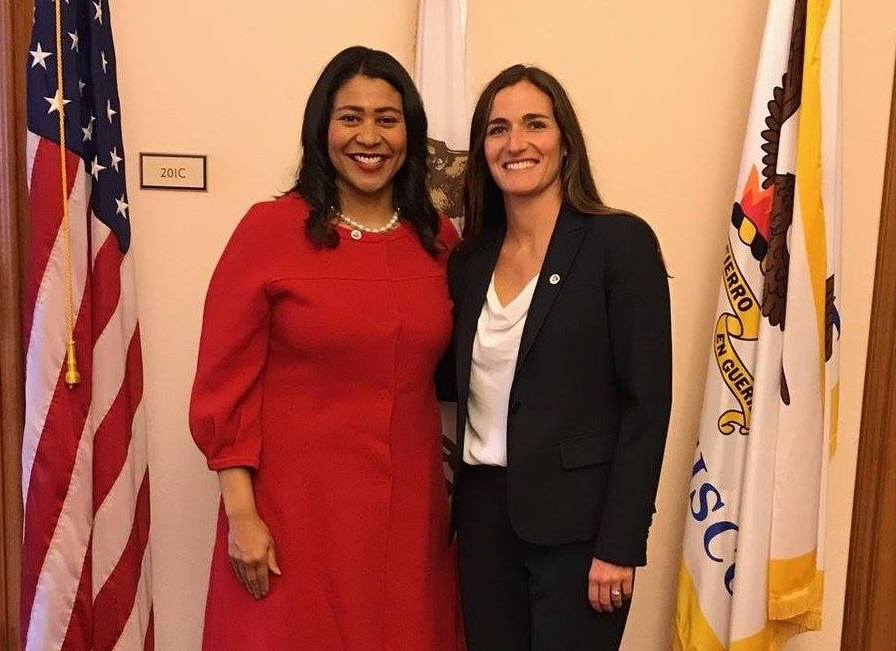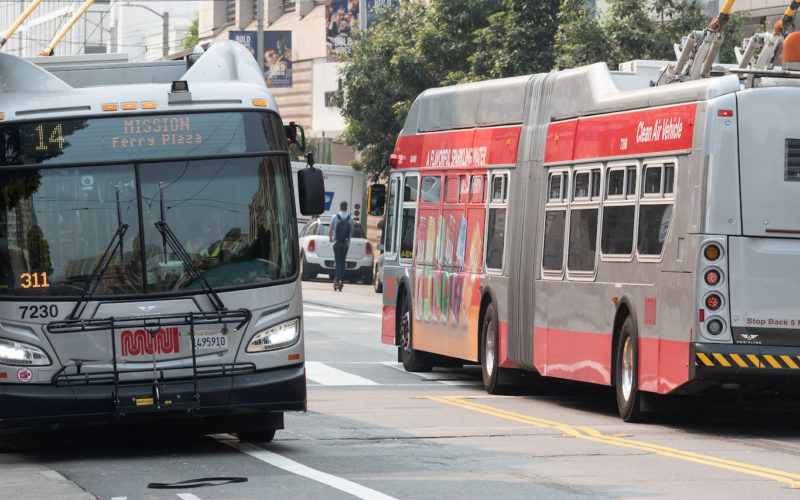

Eaken (right) at her swearing-in ceremony with San Francisco Mayor London Breed
It was a tough summer for the SFMTA. The botched closure of the Twin Peaks tunnel resulted in hundreds of diverted bus routes, hordes of angry riders and calls from the newly-elected Mayor for heads to roll. Manager John Haley was forced out after reports of harassment, creating the impression of a leadership crisis. Meanwhile, congestion in San Francisco is worsening and transit speeds are at an all time low.
Some relief for riders may be on the way with the appointment of Amanda Eaken to the SFMTA Board of Directors. Amanda is the Director of Transportation and Climate at the Natural Resources Defense Council, where she helped to pass SB 375, a first-in-the-nation California law designed to reduce emissions by connecting transportation to land use planning. She’s also a regular bus rider. We chatted with her about how to get San Franciscans out of their cars and back onto transit.
TransitCenter: Why do you think you were picked to be on the board?
Amanda: A big part of the mission of the SFMTA is to create a transit-first city and to promote Vision Zero, and to a certain extent I try to live and embody those goals. In my professional life, I work on sustainable transportation issues with cities around the world and have experience in consensus building with communities and agencies at all levels. I care very deeply about San Francisco and I believe we can become a world class walkable, bike-friendly, transit-first city. But there are real challenges facing San Francisco – increasing traffic congestion and collisions, and a lack of affordable housing.
My commitment to Vision Zero and safe streets could have played a part in my appointment. I really take to heart the testimony we hear from the members of the public about the tragedies that happen every day on our streets. There is no acceptable number of fatalities or injuries to pedestrians, cyclists or drivers. Like Mayor Breed, I hope we can move aggressively and swiftly to make the safety improvements to our high injury network that we know are needed to prevent these injuries and fatalities.
TransitCenter: What challenges are you most excited to take on at SFMTA?
Amanda: I’m very focused on how we can make SF transit a more reliable, enjoyable, and predictable experience for those who use the system. Muni provides over 700,000 daily rides — it’s more than several of the other regional transportation agencies combined– so the system is actually providing a very substantial service for San Francisco residents. And yet, people complain about Muni – it doesn’t show up on time or it’s delayed. I really want to understand and work to address the challenges that are getting in the way of delivering service on schedule, or at least with the frequency that is promised to transit riders. How can we continue to improve the quality of transit service and follow through on San Francisco’s Transit First goals, especially the goal of 80% of trips being taken by sustainable modes by 2030 rather than the current 50%?
TransitCenter When we talk about improving reliability, we talk about putting transit first, that’s all well and good in the abstract, but in practice, that means being at board meetings and confronting people angry about you taking their parking away! How do you envision yourself negotiating that?
Amanda: This is the story of the battle for street space that is playing out all across the country. I had an interesting conversation with the Chief Sustainability Officer from the City of Honolulu, which is one of the cities in the American Cities Climate Challenge, a new initiative designed to support 20 US cities to accelerate their climate efforts. He was reflecting that the City has ambitious goals for encouraging people to walk, bike and ride transit to get around. And yet, if you look at the design of their streets, the amount of street space allocated to these modes is nowhere near the 10%, 15%, or 20% of all trips that Honolulu is aiming for. If we’re serious about sustainable transportation, then we have to align the allocation of our assets with our aspirations.
At the same time, I am sympathetic to the maddening experience of circling the block for 45 minutes looking for parking – I’ve been in that position many times. But as we think about how to address the situation, I want to talk about parking solutions that actually work. Yes, parking management programs, but also making car sharing much more seamless. How could we make car sharing and other new mobility solutions much easier for people and alleviate some of this parking frustration?
TransitCenter: Do you see yourself as having a role in helping to shape the internal culture at the SFMTA?
Amanda: One of the things I said in my confirmation hearing was that I want to bring a solutions orientation and a sense of urgency to addressing some of the challenges facing the agency. When I speak to some of the SFMTA employees who, for example, train the drivers, or are working to build the central subway project, I hear an incredible sense of pride in the work of this agency, and how important this transit system is to the city. I want to bring a sense of that pride in the system and the importance of the work that the amazing employees are engaged in every day. I also want to bring a sense of urgency to breaking down some of the challenges that are getting in the way of achieving the strategic plan goals, like delivering 100% of promised transit service. A few examples: What is getting in the way of delivering 100% of service? Some say it’s a problem of driver availability. Why is driver availability a problem? What’s the root challenge there? I’ll be continuing to probe and ask those questions to get to the root of the problem, and hopefully be able to help surface some solutions.
TransitCenter: Californians pride themselves on being “green”, but it’s proven especially difficult to get them out of their cars. How do you see yourself shaping that debate as a board member, particularly as it relates to say, congestion pricing?
Amanda: An item at the last SFMTA board meeting was a presentation by the San Francisco County Transportation Authority about the congestion impacts of the transportation network companies of Lyft and Uber. One of the findings of the report was that in certain parts of San Francisco up to 50% of the traffic congestion that we’re experiencing on a daily basis is due to the growth of Lyft and Uber rides.
And of course, as a member of a policy-making board, I asked the staff member presenting the report what he recommended we do about this now that we’ve identified this problem? One of my colleagues raised congestion pricing as a potential solution. There was a piece of legislation passed in Sacramento last year that authorized San Francisco, with a public vote, to impose a fee on Lyft and Uber rides, and obviously that’s a conversation happening across the country – there’s a new sense of urgency to address that problem. So maybe it looks like a fee, maybe it’s an incentive or maybe it’s raising the quality of transit service. We focus quite a bit on infrastructure as a solution to achieve our sustainability goals, but spend less time discussing, piloting and measuring the effectiveness of incentives and disincentives to encourage greater use of sustainable modes of travel. I think that’s a really appropriate next conversation.
TransitCenter: Anything else you’d like to add?
Amanda: We’re about to renovate our house, and we were thinking about where we could live during the renovation. Last night during dinner my older daughter said, “We just need to live somewhere along the 24-Line, because then I could take the 24 to school.” I love that she’s already figured out the connection between transit and her own independence.
 On the Brink: Will WMATA’s Progress Be Erased by 2024?
On the Brink: Will WMATA’s Progress Be Erased by 2024?
The experience of being a WMATA rider has substantially improved over the last 18 months, thanks to changes the agency has made like adding off-peak service and simplifying fares. Things are about to get even better with the launch of all-door boarding later this fall, overnight bus service on some lines starting in December, and an ambitious plan to redesign the Metrobus network. But all of this could go away by July 1, 2024.
Read More What’s Going on With Transit Service at the Seven Highest Ridership U.S. Cities? SF Edition
What’s Going on With Transit Service at the Seven Highest Ridership U.S. Cities? SF Edition
As of March 2022, SFMTA was operating 88% of pre-pandemic service and added back even more service in July.
Read More